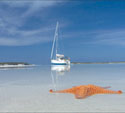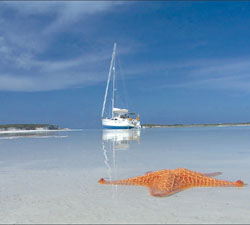Bahamas – Out Islands

 This year Paul and I celebrated 20 years of long-distance cruising. As writers and documentary filmmakers we’re fortunate that we can work while we travel and since setting sail from Toronto in September 1989 on our first international voyage we have logged 76,000 nautical miles cruising to over 50 countries on 5 continents. And whenever anyone asks, “What’s your favourite place to sail?”, we both say without hesitating, “The Bahamas!”.
This year Paul and I celebrated 20 years of long-distance cruising. As writers and documentary filmmakers we’re fortunate that we can work while we travel and since setting sail from Toronto in September 1989 on our first international voyage we have logged 76,000 nautical miles cruising to over 50 countries on 5 continents. And whenever anyone asks, “What’s your favourite place to sail?”, we both say without hesitating, “The Bahamas!”.
The Bahamas rates tops in our books because it has the best mix of all the things we both enjoy – great sailing conditions, warm climate, numerous remote anchorages with innumerable areas of natural beauty that you can only reach by boat; incredibly clear turquoise water great for swimming, snorkelling and diving; friendly laid-back people who are proud of their islands and welcome visitors especially in the small settlements we like to visit; you can live simply and self-sufficiently onboard in the out islands yet for contrast you can easily sail to areas where the night life and resort facilities are top-notch; and for Canadians it is pretty connected by air if you need to get home in an emergency or you want to have visitors fly in to visit.
In fact, when we were new to cruising, the accessibility of the Bahamas by boat was what first attracted us to these tropical islands that lie east of Florida and Cuba. From our home port on Lake Ontario we could pretty much daysail all the way there in protected waters. We travelled through the Erie Canal and Hudson River to New York, then waited for good weather to make quick hops down the New Jersey coast to the Delaware and Chesapeake Bays where in Norfolk, VA we entered the Intracoastal Waterway which takes you on a safe and interesting route all the way to Florida. From ports on the Florida coast, it’s only about 55 nm across the Gulf Stream to clear-in to the Bahamas in Bimini or at West End, Grand Bahama, so you wait for good weather and do it one jump. Tah-dah! You’re in paradise and can island-hop for months – in fact years – and many do.
So if it’s so great and relatively safe and easy to get there by boat, why don’t more people go there? The major block for most sailors is that there is a lot of shallow water throughout the Bahamas. In fact, the name “Bahamas” is derived from the Spanish term for shallow seas, “Baha Mar”. The islands and surrounding seas are naturally formed on huge tablelands of limestone, coral and sand with reef-fringed platforms on the edge of the Atlantic Ocean. The average depths are 3-9 metres (or 10-30 feet). This combination can make navigation somewhat challenging for deep draft vessels. And since it is an immense country – similar in size to the entire Caribbean with over 700 islands and cays (pronounced “keys”), most of them uninhabited, it’s almost impossible for the small population to reliably maintain aids to navigation. But it is these very things that make the the Bahamas such a pristine and beautiful cruising ground and I assure you the obstacles are easily overcome.
Firstly, the water is so incredibly clear and with such a pure sand bottom that you soon learn to read the depths of the water by the colour. Dangerously shallow water appears white to pale yellow, then pale blue as the water deepens to reasonable boating depths, and then very deep blue when the seas becomes very deep. There are dramatically deep ocean drop-offs surrounding the islands in places too. Coral reef looks distinctively black or dark brown with clear defined edges if close to the surface. Weed patches are green or brown with a soft look about them. Soon you don’t miss having aids to navigation. A good pair of polarized sunglasses cuts the glare off the water and enables you to see down into the water more clearly. When navigating through coral or very shallow water with shifting sandbars, plan to do it with the sun behind you so there is no glare.
Our first sailboat, a Sparkman and Stevens design called a Classic 37, had a full cut-way fixed keel with a 6-foot draft and we cruised through the islands for several seasons without problems. Of course, we had to watch the tides and study our charts carefully and there were a few places we just couldn’t get to, but there are so many islands to explore and so many safe harbours to run to in the Bahamas that we never felt restricted. However, the more we came to know and love these islands and the more skilled we got at navigating through the shallow seas, banks, and surrounding reefs, the more curious we felt about what the really shallow, and therefore remote, places were like. So when we discovered the British-built Southerly yacht with a retractable keel that goes from a 9-foot draft for ocean-going performance to a draft of 2-foot 10-inches for shallow water gunkholing, we knew it was the boat for us for returning to the Bahamas. And that’s why you see a lot of multi-hulls and other shallow draft vessels, both power and sail, cruising these waters.
Most Canadian and Americans from the cold north plan their cruise of the Bahamas in the winter months and then leave the islands in the spring so they are home for the summer to avoid hurricane season in this region which runs roughly from June to October. The weather in the Bahamas is definitely warm and “summery” in the winter but during these months, the winds are consistently stronger and there are more frequent winter storms called “northers”, powerful fronts that roll down from the United States. But you can easily hide from them in the numerous protected harbours and anchorages scattered all over the Bahamas; they’re just a nuisance. The further south you go the less northers make it down to you. That’s why the Exumas and other island groups further south are popular cruiser hang-outs in the wintertime.
In spring, in April and May, when most sailors start leaving the Bahamas and the Caribbean, the weather starts to get really nice in the islands. The winds become more gentle but still good for sailing and the seas are generally smooth so also great for snorkelling and swimming. This is the season when you see more powerboats and small sailboats making the run over from Florida to the Bahamas since conditions are more comfortable, especially for fishing which seems to be the major pastime for boaters in the spring.
Our return to the Bahamas in our new boat was everything we hoped it would be! After sailing the boat transatlantic from England for a winter cruise through the islands of the Caribbean we headed north for the Bahamas from the US Virgin Islands in May for a spring cruise before the start of the summer hurricane season. Abraham’s Bay, Mayaguana, which is one of the more southern ports of call for clearing in to the Bahamas, is about a three and a half day passage. Here we were welcomed at the dinghy-dock by local resident, Yule Charlston, who told us about the weekly Saturday beach party and invited us to join in the fun. Yule introduced us to many of the villagers and we felt at home in no time. This was out island cruising at its finest!
From Mayaguana we sailed 70 miles west to the remote Crooked and Acklins archipelago where we explored the Bight, retracting the keel and beaching our boat at low tide amongst the sandbars where wild flamingos tiptoed on the salt ponds around us. We visited settlements where they rarely see visitors and were welcomed into homes and communities. This year we visited the Jumentos Cays, another remote southern island group, where we only saw a two other cruising boats in two weeks and then had a chance meeting with the off-shore fishing fleet from Spanish Wells on the last day before heading up to the Exumas. This opened many doors for us when later we visited Spanish Wells near the major island of Eleuthera. Diving on the untouched reefs was amazing, the birdlife was fascinating and the sunsets memorable.
In June we re-discovered the Exumas, one of our favourite Bahamian island groups from past winter cruises, especially exploring the strikingly beautiful yet shallow Pipe Creek area where magical ribbons of blue water twist amongst pale sand bars and you can have a crystal sand beach to yourself everyday. And yet it’s just a dinghy ride away to the settlement at Staniel Cay with all the fun and conveniences of a micro-tourist resort.
It’s this contrast and diversity that makes the Bahamas such a wonderful place to explore by boat. If you are considering a cruise south, we urge you not to miss this paradise.




























